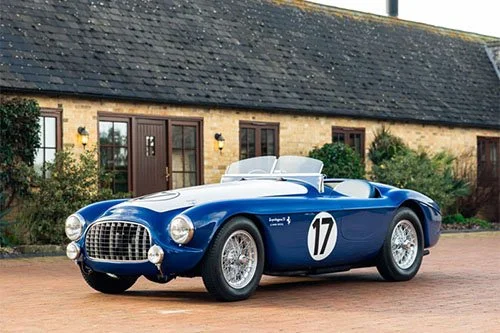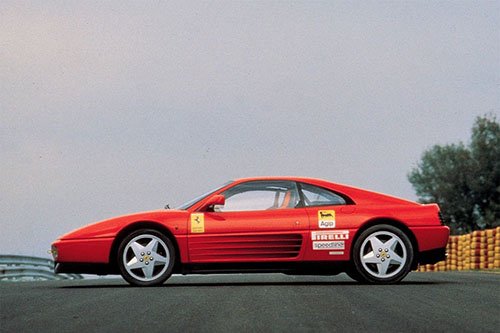Guide: Ferrari Dino 308 GT4
Background
With the critically acclaimed Dino 206 and 246, Ferrari had successfully broken into the market for mid-range premium brand sports cars.
However, Porsche were still the undisputed champions in this department; sales of the 911 in its various guises routinely exceeded 10,000 units per year which left manufacturers like Ferrari, Lamborghini and Maserati looking on enviously.
The Italian firms often lurched from one financial crisis to another and management understandably thought a junior model that could sell in far greater volumes would bring some much needed stability to their companies.
Despite the two-seat Dino selling well, the 911's huge popularity was considered in no small part down to the additional practicality if offered by having an extra pair of seats in the back. Ferrari, Maserati and Lamborghini were convinced they also needed a junior model that offered a 2+2 layout, but rather than build a rear-engined model like Porsche, all three tried to shoehorn four seats into a mid-engined configuration.
Lamborghini gambled the most and expanded their Sant’Agata factory to produce the Urraco. Unfortunately, the new car failed to sell in the anticipated quantity and nearly brought the firm to its knees.
Maserati created the Merak, but they, along with parent company Citroen, were also in financial trouble by the mid 1970s.
Of the three firms, Ferrari undoubtedly did the best job and, from a commercial perspective, the new 308 GT4 dramatically outsold its domestic rivals.
Launched alongside the 365 GT4 BB at the Paris Motor Show in October 1973, the 308 GT4 slotted into a Ferrari line up that also comprised the four seat 365 GT4 and the Dino 246 that would soon be replaced by the 308 GTB.
In addition to being a new type of car for Ferrari, the 308 GT4 was unusual in that Pininfarina were not responsible for the styling. Instead, body design and production was handled by Bertone who were arguably the most influential studio of the era.
Initially badged as a Dino (like the 206 and 246), only those 308 GT4s built in the second phase of production from mid 1975 were equipped with Ferrari's prancing horse emblems.
Chassis
The 308 GT4 was built around a Tipo F106 AL 100 tubular steel chassis which was basically an enlarged version of the type used on earlier 246 models. There were separate square tube subframes for the engine, suspension, steering and bumpers while the floors, inner wheelarches and front bulkhead were formed in glassfibre.
Compared to the 246, track was widened by 35mm at the front and 30mm at the rear.
The wheelbase was stretched by 210mm (to 2550mm) thus freeing up additional cabin space.
Suspension was independent all round via unequal length wishbones, coil springs and Koni shock absorbers. Anti-roll bars were installed front and rear.
A dual circuit brake system employed ventilated discs to all four corners.
Cromodora 6.5 x 14-inch cast alloy wheels came with distinctive chrome hubs to cover the lug bolts. Michelin XWX tyres were usually fitted.
Capacity of the two fuel tanks was a combined 80-litres. The tanks were mounted either side of the engine up against the rear bulkhead.
Engine / Gearbox
Considering the variety of engines produced by Ferrari over the years, it was perhaps surprising the firm had never developed a successful V8. There had of course been those Carlo Chiti-designed V8s used for sports car racing in 1962, but these had quickly been abandoned owing to weight and power issues.
Nevertheless, Ferrari recognised a brand new 90° V8 would be the best option for the 308 range.
The transversely mounted Tipo F106 AL power unit featured a cast alloy block, cylinder head and sump. It was equipped with wet-sump lubrication, belt driven dual overhead camshafts and two valves per cylinder.
Displacement was 2926cc thanks to a bore and stroke of 81mm and 71mm respectively. Interestingly, these were precisely the same bore and stroke measurements used on the 365 series of V12 engines.
Compression was set at 8.8:1 and there were four Weber 40 DCNF downdraught carburettors plus two Marelli distributors.
Peak output was 255bhp at 7700rpm and 210lb-ft at 5000rpm.
As had been the case with the Dino GT, a five-speed gearbox was mounted in unit with the engine. It was located below and to the rear of the sump. Transmission was via a single dry plate clutch and limited-slip differential.
Bodywork
Considering every production Ferrari since 1953 had been designed by Pininfarina, it was something of a surprise when Bertone were contracted to create the new model.
However, Bertone were at the forefront of the wedge design movement and had been recommended to Ferrari by parent group Fiat after a successful collaboration for the handsome Fiat Dino Coupe.
Bertone had also executed a handful of beautiful coachbuilt bodies on various 250 GT platforms.
They could not have been given a trickier concept than the mid-engined 2+2 layout though.
The finished design featured a mix of flat surfaces, sharp creases and short overhangs.
Most body panels were manufactured from steel although the engine cover and front lid were aluminium and the front grille housing was fibreglass.
A plane-like front hood incorporated retractable headlights and a matt black bank of vents to cool the radiators. The full width steel bumper received a black rubberised coating (although some were fibreglass instead).
The bumper was housed (like at the rear) in a chrome surround to match the window frames, windscreen wipers, badges and door handles.
The cockpit merged with the rear fenders by way of flying buttresses that swept down to the tail either side of a flat deck and vertical rear screen.
Boomerang air intakes were located behind the rear quarter windows; the one on the left fed cool air into the oil radiator and the one on the right to the carburettors.
At the back, triple light clusters per side were housed in a distinctive red reflective shroud.
Interior
As expected, an all new interior was created for the 308 GT4. However, with limited head and leg room, the much-heralded rear seats were not suitable for adult use in anything other than an emergency.
Customers were given the choice of having the rear seats replaced with a trimmed luggage platform, but few took this option up.
Standard upholstery was vinyl with fabric inserts. The dash was also trimmed in vinyl.
The instrument binnacle was angled towards the driver at each end and came with a natural alloy fascia. In the centre were large gauges for road and engine speed plus smaller read outs for oil pressure, oil temperature, water temperature, fuel and a clock. The angled corners were home to the ventilation controls plus a number of switches and warning lights.
The leather-rimmed Momo steering wheel featured three natural aluminium spokes to match the dash fascia.
An open gate transmission was retained. The electric window switches were located alongside the gear lever and the radio was curiously mounted just ahead.
Options
Buyers could enhance their cars with a variety of optional extras to include a full leather interior, wider 7-inch Campagnolo five-spoke alloy wheels, air-conditioning, electric windows, metallic paint and the Boxer colour scheme that saw the lower half of the body painted satin black.
A manual sunroof, tinted glass, rear seat delete and a heated rear window were also available.
Weight / Performance
Ferrari quoted a weight of 1265kg, a top speed of 155mph and 0-62mph time of 6.6 seconds.
USA Version
308 GT4s destined for the USA were subject to considerable modification in order to meet Federal safety and emissions standards.
Engines were equipped with different versions of the 40 DCNF carburettors, different manifolds and multiple air injection points. Output dropped to 240bhp at 6600rpm.
Other differences on US versions included extended bumpers with additional bracing and a reinforced rear bulkhead. There were also rectangular side marker lights, matt black front and rear aprons, a matt black front grille with no driving lights and red rear indicator lenses instead of amber.
Other markets that adopted the US-specification in part or full were Australia and Japan.
The changes made to these Federalised derivatives added around 90kg.
As twelve cylinder models like the 365 GT4 and BB were not adapted for the US market, once the 246 GT and GTS were discontinued in 1974, the 308 GT4 was temporarily the only model available through the official American network. As far as the unfortunate dealers were concerned, it wasn't even badged as a Ferrari.
Production Changes
A package of updates were brought in during July 1975.
The most obvious change was the switch from Dino to Ferrari badges and the option of new five-spoke star-pattern Campagnolo wheels.
Additionally, a subtly reworked lower nose panel housed a full width front grille with the auxiliary lights now mounted behind it rather than exposed in each corner.
Inside, electric windows, a heated rear windscreen and tinted glass were made standard along with an extended lower dash.
In January 1978, a new Marelli Digiplex electronic ignition with a single distributor and coil replaced the earlier arrangement. Different variants of the Weber 40 DCNF carburettor were also installed and output dropped to 230bhp at 7700rpm.
At the same time, catalytic converters were fitted to US derivatives (which retained the original twin distributor set up). 35bhp was lost as power dropped to 205bhp.
End of Production
Production ended in December 1980 after 2826 examples had been built (547 of which were right-hand drive).
Additionally, 840 two-litre versions were built for the Italian market after tax levies were introduced on vehicles with engines over 2000cc. The 208 GT4 is covered separately.
Chassis numbers for all variants ranged from 07202 to 15604.
Text copyright: Supercar Nostalgia
Photo copyright: Ferrari - https://www.ferrari.com






































